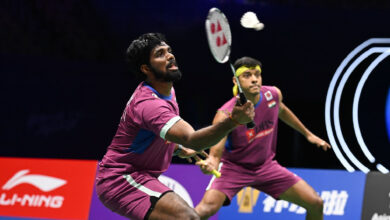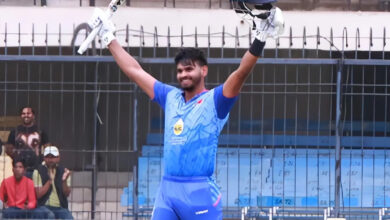ICC Cricket World Cup: With a high-class spell, Pakan fast bowler Haris Rauf finds form at the right time | Cricket-world-cup News

The eyes of Babar Azam wandered to the fine-leg fence. His gaze met that of Haris Rauf, fidgeting in his dant outpost, stretching his legs and straining his necks to signal that he is half a gesture from another spell. He seemed even more restless, even more eager to feel the leather on his palms, because he has not quite been the Rauf — HR150 as he scribbles in autographs — the world has whispered in awe and dread.For much of the last month, he had bowled like an out-of-tune sitar, notes jarring from his fingers. In the warm-up against Australia, he bled 97 runs; against New Zealand, his four overs leaked 36 runs. In the Asia Cup, he was sporadically incisive; in the New Zealand series, he conceded six per over thrice in seven games. But it often takes just a spell to regain paradise.
So with the Netherlands at 108 for two, the match drifting away a trifle, Babar reckoned it was the ripest time to summon his middle-over enforcer. His first three overs were effective without being spectacular. He was bowling with pace, but not with the fire. And then he bounded in, howling like the wind on a windless evening. He played the usual riffs—back of length, back of length, length, full length. Then came the lifter. Bas de Leede, batting on 36, was caught unawares.
He wafted the thin air almost as it hustled into the gloves of Rizwan.
Suddenly you feel the menace, the dread and agony, the sniff of doom. Rauf pounded the shorter length again. This time the ball flew faster, though De Leede somehow managed a top-edge. This was pure nastiness; Rauf uncensored; Rauf unplugged. Suddenly, the smooth-sailing Dutch ship felt like being tossed in a violent sea. The well-set Vikramjit Singh slogged sheepishly to gift the wicket to left-arm spinner Mohammed Nawaz. The wicket probably owed to the fear Rauf had induced. Two overs, Rauf became fear itself.
He was suddenly in the middle of a dream spell. The rhyme and rhythm, the snap and bite had all returned. In a spell that was a savage theatre of high-class, high-art pace bowling. he cut the Dutch resance into ribbons. In three balls, he winkled out captain Scott Edwards and Teja Nidamanuru. He could have grabbed a third but for the greasy palms of Iftikhar Ahmed at first slip to reprieve Saqib Zulfiqar.
It was so physically exacting a spell that Rauf would slip in the sheer intensity of his landing, kicking up grey plumes of brown dust. Rauf is a fast-bowling spectacle, as he explodes off a meandering run-up, before pivoting his shoulders and vigorously flexing his low back in his release. The ball thunder-bolted off the surface, seemingly gathering pace as it burst off the surface and screamed into the batsmen, who seemed like a fugitive trying to fend off an entire firing squad with the bat.
Pakan’s bowler Haris Rauf during the ICC Men’s Cricket World Cup match between Pakan and Netherlands, at Rajiv Gandhi International Cricket Stadium, in Hyderabad. (PTI)
The game had an entirely different feeling to it once Rauf came for the second spell. At that speed, cricket is a game played right out on the limits. And he made Pakan’s bowling unit looks untamable, even invincible. Later De Leede would admit: “Everything had to be quicker when pacing him.” The judgement, the execution, the feet and the mind.
It was a brutal vindication of the explosiveness of Pakan’s quicks. It is heinous to ever doubt the quality of Pakan’s bowlers, but doubts lingered. Their most consent one Naseem Shah, he of that divine action, was ruled out of the tournament, much like Waqar Younis was before the 1992 World Cup. There undoubtedly is Shaheen Shah Afridi, but one bowler alone cannot define a World Cup. He needed the support cast. He needed Rauf to rediscover his hostility; he required Hasan Ali to make a fuss-free comeback after not playing ODIs for 14 months; he required the spinners to chime in, the part-timer to chip in. All the requirements were met.
Hasan bowled with cunning and smart, produced swing with the new ball and seam movement with the old ball, though never hitting frightening pace. But his bouncers are slippery, as Max O’Dowd realised. His nip-backers are nippier than you think. Allied with discipline, he could be a dangerous proposition, and that is even without him digging into his full kit of variations. Afridi himself settled into a delightful rhythm, and towards the end, purchased reverse swing, that one ingredient that makes a deadly attack deadlier.Most Read
1
Inside Parineeti Chopra’s grand welcome at Chadha house: Actor reveals she said ‘I love you’ first, couple play fun post-wedding games
2
Rhea Chakraborty says she was aware of Sushant Singh Rajput’s mental health issues: ‘When someone famous has such issues, people don’t understand it’
See More
The two new balls had made it a difficult task, but with the help of a slightly abraded surface, Afridi reverse-swung, the ball hooping devilishly late into the batsmen’s toes.
The spinners—Shadab Khan and Mohammad Nawaz— too had drawn flak of late for their elusive thriftiness. The logic of fielding two primarily defensive bowlers was questioned too. But both re emphasised their utility, first with the bat in a valuable 64-run partnership when Pakan was tottering at 188 for six. Khan would occasionally err in lengths and feed short balls, but there were clear signs that he is getting back to his thrifty best. Equally heartening would have been the sight of Iftikhar Ahmed picking a wicket off the first ball. Useful spells from part-timers could be decisive as the overlong tournament drags on.
But both the foundation and hope would be founded on the speedsters of Pakan. And on Friday, it was Rauf’s turn to the demolisher. Fittingly, he wrapped up the demolition act blasting the leg-stump of the Netherlands last batsman, Paul van Meekeren. Rauf blew a kiss at him. The kiss of death. And that’s what full inspired Pakan speed demons do.







